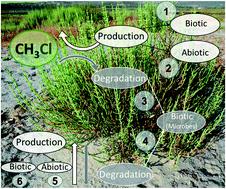当前位置:
X-MOL 学术
›
Environ. Sci.: Processes Impacts
›
论文详情
Our official English website, www.x-mol.net, welcomes your feedback! (Note: you will need to create a separate account there.)
Sources and sinks of chloromethane in a salt marsh ecosystem: constraints from concentration and stable isotope measurements of laboratory incubation experiments.
Environmental Science: Processes & Impacts ( IF 5.5 ) Pub Date : 2020-02-12 , DOI: 10.1039/c9em00540d Frank Keppler 1 , Amelie Ninja Röhling , Nicole Jaeger , Moritz Schroll , Simon Christoph Hartmann , Markus Greule
Environmental Science: Processes & Impacts ( IF 5.5 ) Pub Date : 2020-02-12 , DOI: 10.1039/c9em00540d Frank Keppler 1 , Amelie Ninja Röhling , Nicole Jaeger , Moritz Schroll , Simon Christoph Hartmann , Markus Greule
Affiliation

|
Chloromethane (CH3Cl) is the most abundant long-lived chlorinated organic compound in the atmosphere and contributes significantly to natural stratospheric ozone depletion. Salt marsh ecosystems including halophyte plants are a known source of atmospheric CH3Cl but estimates of their total global source strength are highly uncertain and knowledge of the major production and consumption processes in the atmosphere-halophyte-soil system is yet incomplete. In this study we investigated the halophyte plant, Salicornia europaea, and soil samples from a coastal salt marsh site in Sardinia/Italy for their potential to emit and consume CH3Cl and using flux measurements, stable isotope techniques and Arrhenius plots differentiated between biotic and abiotic processes. Our laboratory approach clearly shows that at least 6 different production and consumption processes are active in controlling atmospheric CH3Cl fluxes of a salt marsh ecosystem. CH3Cl release by dried plant and soil material was substantially higher than that from the fresh material at temperatures ranging from 20 to 70 °C. Results of Arrhenius plots helped to distinguish between biotic and abiotic formation processes in plants and soils. Biotic CH3Cl consumption rates were highest at 30 °C for plants and 50 °C for soils, and microbial uptake was higher in soils with higher organic matter content. Stable isotope techniques helped to distinguish between formation and degradation processes and also provided a deeper insight into potential methyl moiety donor compounds, such as S-adenosyl-l-methionine, S-methylmethionine and pectin, that might be involved in the abiotic and biotic CH3Cl production processes. Our results clearly indicate that cycling of CH3Cl in salt marsh ecosystems is a result of several biotic and abiotic processes occurring simultaneously in the atmosphere-plant-soil system. Important precursor compounds for biotic and abiotic CH3Cl formation might be methionine derivatives and pectin. All formation and degradation processes are temperature dependent and thus environmental changes might affect the strength of each source and sink within salt marsh ecosystems and thus considerably alter total fluxes of CH3Cl from salt marsh ecosystems to the atmosphere.
中文翻译:

盐沼生态系统中氯甲烷的来源和汇:实验室培养实验的浓度和稳定同位素测量的限制。
氯甲烷(CH3Cl)是大气中最丰富的长寿命氯化有机化合物,对自然的平流层臭氧消耗有很大贡献。盐沼生态系统(包括盐生植物)是大气中CH3Cl的已知来源,但其全球总来源强度的估算高度不确定,并且对大气-盐生植物-土壤系统的主要生产和消费过程的了解仍不完全。在这项研究中,我们调查了盐生植物,欧洲杯形藻和来自撒丁岛/意大利沿海盐沼站点的土壤样品的排放和消耗CH3Cl的潜力,并使用通量测量,稳定同位素技术和区分生物和非生物过程的Arrhenius图进行了研究。 。我们的实验室方法清楚地表明,至少有6种不同的生产和消费过程可有效控制盐沼生态系统的大气CH3Cl通量。在20至70°C的温度下,干燥的植物和土壤物料释放的CH3Cl明显高于新鲜物料。Arrhenius曲线的结果有助于区分植物和土壤中生物和非生物的形成过程。植物中CH3Cl的生物消耗率最高,土壤30°C时最高,而有机质含量较高的土壤中微生物的吸收率更高。稳定的同位素技术有助于区分形成和降解过程,还提供了对潜在的甲基部分供体化合物(例如S-腺苷-1-甲硫氨酸,S-甲基甲硫氨酸和果胶,可能涉及非生物和生物CH3Cl的生产过程。我们的结果清楚地表明,盐沼生态系统中CH3Cl的循环是大气-植物-土壤系统中同时发生的几种生物和非生物过程的结果。生物和非生物CH3Cl形成的重要前体化合物可能是蛋氨酸衍生物和果胶。所有的形成和降解过程都与温度有关,因此环境变化可能会影响盐沼生态系统内每个来源和汇的强度,从而大大改变了CH3Cl从盐沼生态系统到大气的总通量。我们的结果清楚地表明,盐沼生态系统中CH3Cl的循环是大气-植物-土壤系统中同时发生的几种生物和非生物过程的结果。生物和非生物CH3Cl形成的重要前体化合物可能是蛋氨酸衍生物和果胶。所有的形成和降解过程都与温度有关,因此环境变化可能会影响盐沼生态系统内每个源和汇的强度,从而大大改变了CH3Cl从盐沼生态系统到大气的总通量。我们的结果清楚地表明,盐沼生态系统中CH3Cl的循环是大气-植物-土壤系统中同时发生的几种生物和非生物过程的结果。生物和非生物CH3Cl形成的重要前体化合物可能是蛋氨酸衍生物和果胶。所有的形成和降解过程都与温度有关,因此环境变化可能会影响盐沼生态系统内每个源和汇的强度,从而大大改变了CH3Cl从盐沼生态系统到大气的总通量。
更新日期:2020-02-12
中文翻译:

盐沼生态系统中氯甲烷的来源和汇:实验室培养实验的浓度和稳定同位素测量的限制。
氯甲烷(CH3Cl)是大气中最丰富的长寿命氯化有机化合物,对自然的平流层臭氧消耗有很大贡献。盐沼生态系统(包括盐生植物)是大气中CH3Cl的已知来源,但其全球总来源强度的估算高度不确定,并且对大气-盐生植物-土壤系统的主要生产和消费过程的了解仍不完全。在这项研究中,我们调查了盐生植物,欧洲杯形藻和来自撒丁岛/意大利沿海盐沼站点的土壤样品的排放和消耗CH3Cl的潜力,并使用通量测量,稳定同位素技术和区分生物和非生物过程的Arrhenius图进行了研究。 。我们的实验室方法清楚地表明,至少有6种不同的生产和消费过程可有效控制盐沼生态系统的大气CH3Cl通量。在20至70°C的温度下,干燥的植物和土壤物料释放的CH3Cl明显高于新鲜物料。Arrhenius曲线的结果有助于区分植物和土壤中生物和非生物的形成过程。植物中CH3Cl的生物消耗率最高,土壤30°C时最高,而有机质含量较高的土壤中微生物的吸收率更高。稳定的同位素技术有助于区分形成和降解过程,还提供了对潜在的甲基部分供体化合物(例如S-腺苷-1-甲硫氨酸,S-甲基甲硫氨酸和果胶,可能涉及非生物和生物CH3Cl的生产过程。我们的结果清楚地表明,盐沼生态系统中CH3Cl的循环是大气-植物-土壤系统中同时发生的几种生物和非生物过程的结果。生物和非生物CH3Cl形成的重要前体化合物可能是蛋氨酸衍生物和果胶。所有的形成和降解过程都与温度有关,因此环境变化可能会影响盐沼生态系统内每个来源和汇的强度,从而大大改变了CH3Cl从盐沼生态系统到大气的总通量。我们的结果清楚地表明,盐沼生态系统中CH3Cl的循环是大气-植物-土壤系统中同时发生的几种生物和非生物过程的结果。生物和非生物CH3Cl形成的重要前体化合物可能是蛋氨酸衍生物和果胶。所有的形成和降解过程都与温度有关,因此环境变化可能会影响盐沼生态系统内每个源和汇的强度,从而大大改变了CH3Cl从盐沼生态系统到大气的总通量。我们的结果清楚地表明,盐沼生态系统中CH3Cl的循环是大气-植物-土壤系统中同时发生的几种生物和非生物过程的结果。生物和非生物CH3Cl形成的重要前体化合物可能是蛋氨酸衍生物和果胶。所有的形成和降解过程都与温度有关,因此环境变化可能会影响盐沼生态系统内每个源和汇的强度,从而大大改变了CH3Cl从盐沼生态系统到大气的总通量。


























 京公网安备 11010802027423号
京公网安备 11010802027423号